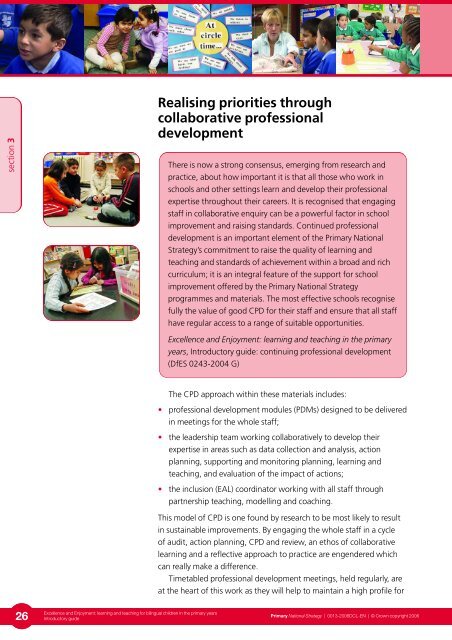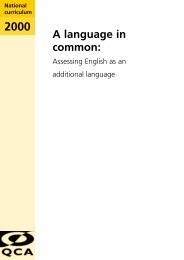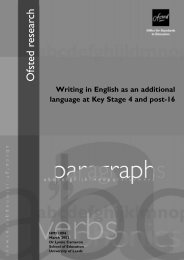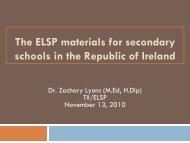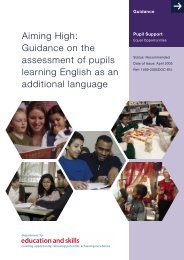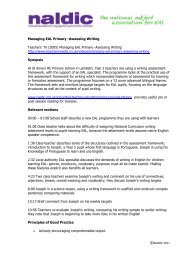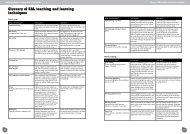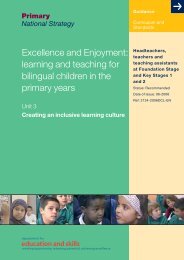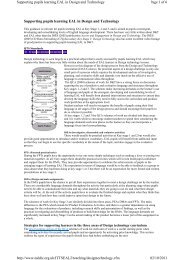Excellence and Enjoyment: learning and teaching for ... - NALDIC
Excellence and Enjoyment: learning and teaching for ... - NALDIC
Excellence and Enjoyment: learning and teaching for ... - NALDIC
You also want an ePaper? Increase the reach of your titles
YUMPU automatically turns print PDFs into web optimized ePapers that Google loves.
section 3Realising priorities throughcollaborative professionaldevelopmentThere is now a strong consensus, emerging from research <strong>and</strong>practice, about how important it is that all those who work inschools <strong>and</strong> other settings learn <strong>and</strong> develop their professionalexpertise throughout their careers. It is recognised that engagingstaff in collaborative enquiry can be a powerful factor in schoolimprovement <strong>and</strong> raising st<strong>and</strong>ards. Continued professionaldevelopment is an important element of the Primary NationalStrategy’s commitment to raise the quality of <strong>learning</strong> <strong>and</strong><strong>teaching</strong> <strong>and</strong> st<strong>and</strong>ards of achievement within a broad <strong>and</strong> richcurriculum; it is an integral feature of the support <strong>for</strong> schoolimprovement offered by the Primary National Strategyprogrammes <strong>and</strong> materials. The most effective schools recognisefully the value of good CPD <strong>for</strong> their staff <strong>and</strong> ensure that all staffhave regular access to a range of suitable opportunities.<strong>Excellence</strong> <strong>and</strong> <strong>Enjoyment</strong>: <strong>learning</strong> <strong>and</strong> <strong>teaching</strong> in the primaryyears, Introductory guide: continuing professional development(DfES 0243-2004 G)The CPD approach within these materials includes:• professional development modules (PDMs) designed to be deliveredin meetings <strong>for</strong> the whole staff;• the leadership team working collaboratively to develop theirexpertise in areas such as data collection <strong>and</strong> analysis, actionplanning, supporting <strong>and</strong> monitoring planning, <strong>learning</strong> <strong>and</strong><strong>teaching</strong>, <strong>and</strong> evaluation of the impact of actions;• the inclusion (EAL) coordinator working with all staff throughpartnership <strong>teaching</strong>, modelling <strong>and</strong> coaching.This model of CPD is one found by research to be most likely to resultin sustainable improvements. By engaging the whole staff in a cycleof audit, action planning, CPD <strong>and</strong> review, an ethos of collaborative<strong>learning</strong> <strong>and</strong> a reflective approach to practice are engendered whichcan really make a difference.Timetabled professional development meetings, held regularly, areat the heart of this work as they will help to maintain a high profile <strong>for</strong>26<strong>Excellence</strong> <strong>and</strong> <strong>Enjoyment</strong>: <strong>learning</strong> <strong>and</strong> <strong>teaching</strong> <strong>for</strong> bilingual children in the primary yearsIntroductory guidePrimary National Strategy | 0013-2006DCL-EN | © Crown copyright 2006


